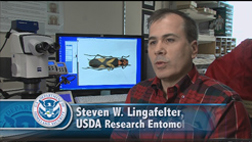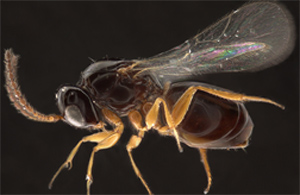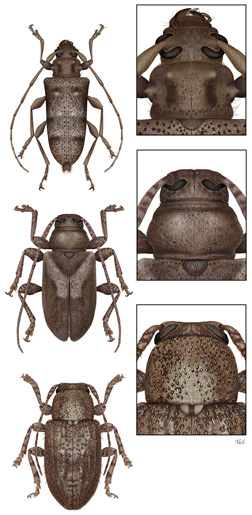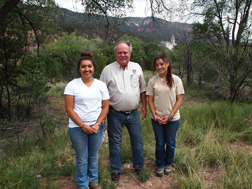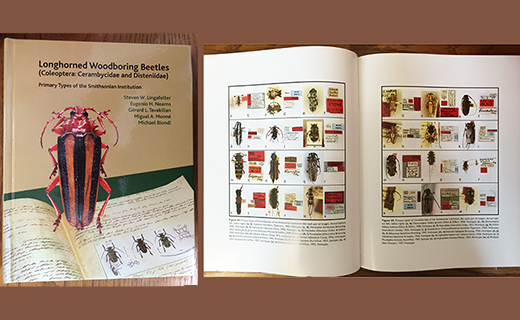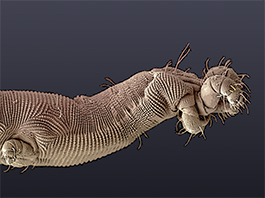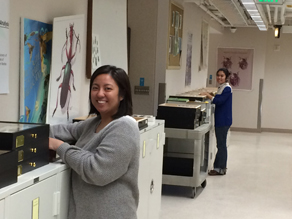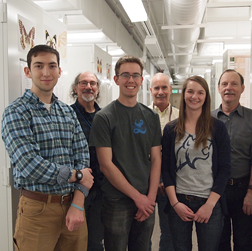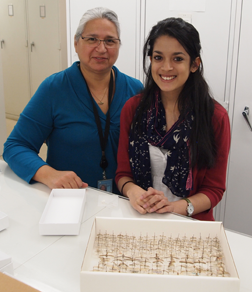| News |

|
|
|
|
|||
|
8/18/2015- |
Dr. Steven W. Lingafelter discusses important research being conducted on exotic woodboring beetles
|
8/12/2015-
Identifying Tiny Wasps
|
Angustocorpa wasp from South Africa |
Congratulations to Matt Buffington for his article in the August edition of AgResearch. The article entitled "Identifying Tiny Wasps" does a nice job in highlighting both Matt's research, SEL, and photomicroscopy. Check it out! http://agresearchmag.ars.usda.gov/2015/aug/wasps/
|
8/12/2015-
Andrew Ulsamer speaks on the importance of pollinators
|
Andy Ulsamer made the USDA's Week in Review (June 29th). Andy, one of our newest members to the SEL team, was recorded during a session about the importance of pollinators:
Congratulations Andy!
Click below to watch him on USDA's Week in Review |
4/27/2015-
The Artist is In - at Q?rius Center
|
On Friday April 17, Taina Litwak, SEL staff illustrator presented a public program in the Q?rius center "Modern Entomological Illustration". She had some specimens and a microscope with camera lucida and demonstrated the process of getting a full color beetle illustration from specimen to sketch to digital painting. |
||
|
10/1/2014-
Student Jessa Thurman
|
Jessa Thurman from Research Entomologist Michael Gates's alma mater interns during the summer of 2014.
|
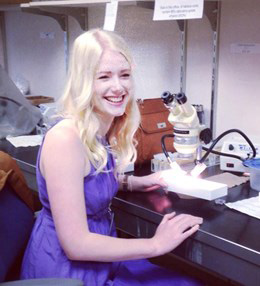 |
8/9/2014-
SEL illustration wins awards
|
More visibility for SEL and entomological illustration!
Taina Litwak's painting of "3 new species of Cerambycid Beetle", done for Dr. Steve Lingafelter, received both an Award of Excellence and the Canadian Founders Award at the BioImages 2014. This is an annual national visual media competition sponsored by the Biocommunications Association.
|
You can see all the winners here.
8/7/2014-
Interns at Valles Caldera National Preserve, New Mexico, discover moths
|
On July 21-23, 2014, Alma Solis, Research Scientist, SEL, taught Kyana Garcia and Ashley Jaramillo, to pin, spread, and identify moths to family. Samantha Cordova, a Biological Technician, also learned how to prepare moths. Kyana and Ashley were summer interns from Highlands University, Las Vegas, New Mexico, at Valles Caldera National Preserve (VCNP), New Mexico, involved in various activities such as monitoring post-fire forests and grasslands for pests and beneficial insects, conducting biological inventories in unique habitats threatened by climate change, and preparing specimens for study.
(Left to Right) Ashley Jaramillo, Robert Parmenter, and Kyana Garcia outside the laboratory at Valles Caldera National Preserve. |

Ashley and Kyana pinning and spreading moths in the laboratory from trap MM T1 collected June 24, 2014. One trap produced 566 moths in total

Ashley and Kyana with the fruits of
their labor.

Samantha Cordova also learned how to prepare moths for study.
7/16/2014-
New book on the Smithsonian Institution Cerambycidae collection authored by Steven Lingafelter published by Smithsonian Scholarly Press and available through Random House Academic Resources
|
The Smithsonian Institution's collection of longhorned woodboring beetles (Coleoptera) is the third largest in the world. United States Department of Agriculture researcher Steven W. Lingafelter and his colleagues worked for over ten years to compile the images and data. The book verifies and presents the data on the original combination, current combination, current tribal classification, and type locality of all species represented by primary types. Longhorned Woodboring Beetles: Primary Types of the Smithsonian Institution is an essential volume for researchers (both professional and amateur), as well as collection managers and other museum personnel.
|
New book on Longhorned Woodboring Beetles: Primary Types of the Smithsonian Institution
|
7/01/2014-
Secretary Vilsack and family visit NMNH
|
|
The image to the left shows Secretary of Agriculture Tom Vilsack and his family viewing the parasitoid wasp Trissolcus japonicus in the Hymenoptera imaging suite during their tour of the Natural History Museum with Research Entomologists Elijah Talamas, Michael Gates, and Gary Miller. |
4/23/2014-
The Buckeye Dragon Mite Osperalycus tererphagus: A new species of Mite
|
The Buckeye Dragon Mite Osperalycus tererphagus |
In December 2013, Ohio State University (OSU) doctoral student Samuel Bolton under the direction of Hans Klompen at OSU finished a 12-month Smithsonian Institute Internship working with Gary Bauchan, (ARS, ECMU) and Ron Ochoa (ARS, SEL) at the Electron and Confocal Microscopy Unit to identify and describe a new, worm-like species of mite belonging to the family Nematalycidae dubbed the "Buckeye Dragon Mite".
Read more about the Buckeye Dragon Mite in the following online resources:
|
4/8/2014-
Curation of the Tribe Cerambycini of the Smithsonian Institution by Spring Break Interns Phyu Pannu Khin (Pannu) and Andrea Camille Santos (Andrea)
|
Above is Andrea in the foreground and Pannu in the background doing the initial sort for this tribe in the main range of the Coleoptera collection. |
Dr. David Adamski of the Systematic Entomology Laboratory selected two interns to work during their spring break in the Entomology Collections of the Smithsonian Institution. Phyu Pannu Khin (Pannu) of Montana State University and Andrea Camille Santos (Andrea) of George Mason University worked with Dr. Steven Lingafelter, curator of the longhorned beetle collection of the Smithsonian Institution, during the week of 10-14 March, 2014 to curate the Tribe Cerambycini.
Click Here to view a pdf and learn more about the work of these interns.
For similar educational opportunities throughout the Smithsonian Click Here. Look for our Lab under "National Museum of Natural History." |
3/31/2014-
SEL hosts Spring Break Interns from Montana State University, Yale University, and University of Maryland at College Park
|
During the week of March 10-14, David Adamski (SEL) arranged for Jonathan Ellison, an undergraduate from Yale University, and Kathryn Pintar and Riley Shearer, undergraduates from Montana State University, to participate in projects in the Lepidoptera section at the National Museum of Natural History, Smithsonian Institution (SI), during their spring break. The following week, March 17-21, Alvira Hasan, University of Maryland at College Park, was also in residence in the Lepidoptera collection. The SEL mentors were John Brown, Mike Pogue and Alma Solis of SEL. |
||
|
3/06/2014-
Alma Solis invited to speak at the Smithsonian Tropical Research Institute in Panama City, Panama
| Alma Solis was invited by Annette Aiello to the Smithsonian Tropical Research Institute in Panama (November 17-23, 2013).
She presented a Tupper Seminar on November 19 entitled "Chasing Snout Moths: A Woman's Quest for Discovery in the Neotropics" in Panama City. She also presented a BAMBI seminar on Barro Colorado Island on November 21 entitled "Snout Moth Feeding and Habits (Lepidoptera: Pyraloidea)." Click on the links below to view high resolution images of each photo: [2] Tupper Center at the Smithsonian Tropical Research Institute, Panama City, Panama [3] Sunset on the Panama Canal.Travel to Barro Colorado Island was by boat on the Panama Canal |
Images from Alma Solis's trip to Panama
|
3/05/2014-
Nick Silverson volunteers in Lepidoptera
|
Nick Silverson curating pyraline moths in the NMNH collection. |
Nick Silverson started the first week of February volunteering as a Research Assistant in Lepidoptera. He is working with Alma Solis on the Pyraloidea and is currently sorting Old World Pyralinae moths destined for final curation. He was at the Invasive Plant Research Lab, ARS, in Ft. Lauderdale, Florida, studying two species of Lepidoptera for the biological control of Brazilian pepper and Chinese tallow. Nick comes from Philadelphia and is looking into future graduate study in ecology. |
02/18/2014-
Dr. Sarah Smith curates the World's largest collection of bark and ambrosia beetles housed at the Smithsonian's National Museum of Natural History, Washington, D.C.
|
The National Collection of bark and ambrosia beetles, already long regarded as one of the finest and most extensive in the World, roughly doubled in size with the aquisition of the Stephan L. Wood Private Collection in 2009. With roughly 180,000 specimens, the combined holdings now span 615 drawers grouped within 31 cabinets. The task of integrating these two collections fell to Dr. Sarah Smith, a recent graduate of Entomology at Michigan State University. Despite her relative youth, Sarah is a well known specialist in bark and ambrosia beetles. She has discovered and described more than a dozen new species in this group, taught at international identification workshops, and collaborated on the development of interactive keys for the World Wide Web. In spite of government closures and extreme weather conditions, Sarah managed to complete what is widely regarded as one of the largest curatorial projects ever attempted in the Smithsonian National Insect Collection. She single-handedly transferred and aligned specimens, verified identifications, organized species and genera within tribes, and printed and inserted new labels for individual trays, drawers, and cabinets filled with bark and ambrosia beetle specimens. Sarah estimates that representatives of about half of the known diversity of these beetles can now be found within the collection, making it unarguably the largest collection of these beetles both in terms of specimens and number of distinct species. |
During her last day on the project, Sarah Smith moved down the aisle with a cat-like grace, shifting drawers into their final positions and attaching new labels to the cabinet doors
|

| The newly curated National Bark and Ambrosia Beetle Collection provides an unparalleled resource for forest entomologists, scolytine systematists, and other individuals concerned with conservation and forest health.
Funding to pay for Sarah's contract work was provided by the Smithsonian Institution and the US Forest Service. David Furth, SI Department of |
ARS News Articles

